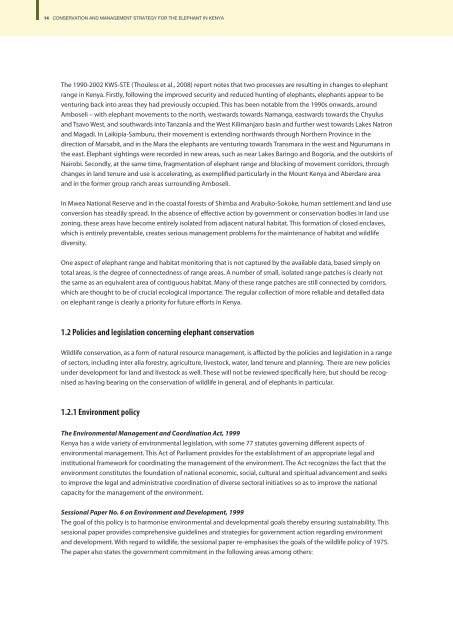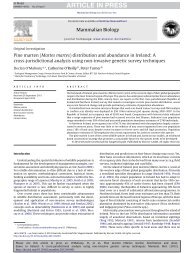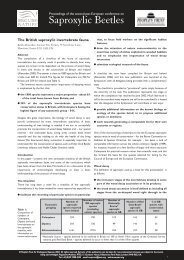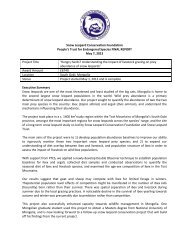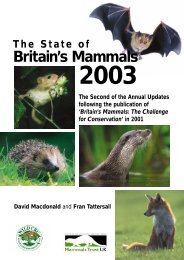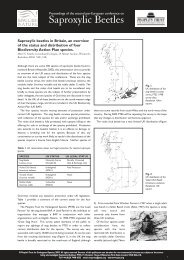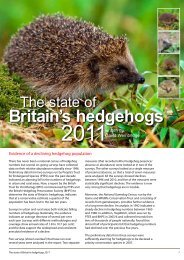National Elephant Strategy - People's Trust for Endangered Species
National Elephant Strategy - People's Trust for Endangered Species
National Elephant Strategy - People's Trust for Endangered Species
Create successful ePaper yourself
Turn your PDF publications into a flip-book with our unique Google optimized e-Paper software.
14 CONSERVATION AND MANAGEMENT STRATEGY FOR THE ELEPHANT IN KENYACONSERVATION AND MANAGEMENT STRATEGY FOR THE ELEPHANT IN KENYA 15The 1990-2002 KWS-STE (Thouless et al., 2008) report notes that two processes are resulting in changes to elephantrange in Kenya. Firstly, following the improved security and reduced hunting of elephants, elephants appear to beventuring back into areas they had previously occupied. This has been notable from the 1990s onwards, aroundAmboseli – with elephant movements to the north, westwards towards Namanga, eastwards towards the Chyulusand Tsavo West, and southwards into Tanzania and the West Kilimanjaro basin and further west towards Lakes Natronand Magadi. In Laikipia-Samburu, their movement is extending northwards through Northern Province in thedirection of Marsabit, and in the Mara the elephants are venturing towards Transmara in the west and Ngurumans inthe east. <strong>Elephant</strong> sightings were recorded in new areas, such as near Lakes Baringo and Bogoria, and the outskirts ofNairobi. Secondly, at the same time, fragmentation of elephant range and blocking of movement corridors, throughchanges in land tenure and use is accelerating, as exemplified particularly in the Mount Kenya and Aberdare areaand in the <strong>for</strong>mer group ranch areas surrounding Amboseli.In Mwea <strong>National</strong> Reserve and in the coastal <strong>for</strong>ests of Shimba and Arabuko-Sokoke, human settlement and land useconversion has steadily spread. In the absence of effective action by government or conservation bodies in land usezoning, these areas have become entirely isolated from adjacent natural habitat. This <strong>for</strong>mation of closed enclaves,which is entirely preventable, creates serious management problems <strong>for</strong> the maintenance of habitat and wildlifediversity.One aspect of elephant range and habitat monitoring that is not captured by the available data, based simply ontotal areas, is the degree of connectedness of range areas. A number of small, isolated range patches is clearly notthe same as an equivalent area of contiguous habitat. Many of these range patches are still connected by corridors,which are thought to be of crucial ecological importance. The regular collection of more reliable and detailed dataon elephant range is clearly a priority <strong>for</strong> future ef<strong>for</strong>ts in Kenya.1.2 Policies and legislation concerning elephant conservationWildlife conservation, as a <strong>for</strong>m of natural resource management, is affected by the policies and legislation in a rangeof sectors, including inter alia <strong>for</strong>estry, agriculture, livestock, water, land tenure and planning. There are new policiesunder development <strong>for</strong> land and livestock as well. These will not be reviewed specifically here, but should be recognisedas having bearing on the conservation of wildlife in general, and of elephants in particular.1.2.1 Environment policyThe Environmental Management and Coordination Act, 1999Kenya has a wide variety of environmental legislation, with some 77 statutes governing different aspects ofenvironmental management. This Act of Parliament provides <strong>for</strong> the establishment of an appropriate legal andinstitutional framework <strong>for</strong> coordinating the management of the environment. The Act recognizes the fact that theenvironment constitutes the foundation of national economic, social, cultural and spiritual advancement and seeksto improve the legal and administrative coordination of diverse sectoral initiatives so as to improve the nationalcapacity <strong>for</strong> the management of the environment.Sessional Paper No. 6 on Environment and Development, 1999The goal of this policy is to harmonise environmental and developmental goals thereby ensuring sustainability. Thissessional paper provides comprehensive guidelines and strategies <strong>for</strong> government action regarding environmentand development. With regard to wildlife, the sessional paper re-emphasises the goals of the wildlife policy of 1975.The paper also states the government commitment in the following areas among others:• Involve local communities and other users in wildlife conservation and management.• Develop mechanisms that allow communities to benefit from wildlife earnings.• Harmonise different wildlife development and conservation activities in protected and dispersal areas.• Establish zones that permit multiple use management of wildlife and assess the status of all vital wildlifehabitats in the country.• Prepare management plans <strong>for</strong> their conservation and management.The <strong>National</strong> Biodiversity <strong>Strategy</strong>, 2000The overall objective of the <strong>National</strong> Biodiversity <strong>Strategy</strong> and Action Plan (NBSAP) is to address the national andinternational undertakings elaborated in Article 6 of the Convention on Biological Diversity (CBD). It is a nationalframework of action <strong>for</strong> the implementation of the Convention to ensure that the present rate of biodiversity lossis reversed, and the present levels of biological resources are maintained at sustainable levels <strong>for</strong> posterity. Thegeneral objectives of the strategy are to conserve Kenya’s biodiversity; to sustainably use its components; to fairlyand equitably share the benefits arising from the utilization of biodiversity resources among stakeholders; and toenhance the technical and scientific cooperation nationally and internationally, including the exchange ofin<strong>for</strong>mation in support of biological conservation.1.2.2 Wildlife policy and legislationThe Wildlife Policy (Sessional Paper No. 3 of 1975)This is the first, and to present only, policy that has governed wildlife management in Kenya since the 1970s and itsgoal is ‘to optimize the returns from this resource, taking account of returns from other <strong>for</strong>ms of land use’.The policy includes:• the primary goal of wildlife conservation as the optimization of returns from wildlife defined broadly to includeaesthetic, cultural, scientific and economic gains, taking into account the income from other land uses;• the need to identify and implement compatible land uses and fair distribution of benefits derived from wildlifeincluding from both non-consumptive and consumptive uses of wildlife;• the need <strong>for</strong> an integrated approach to wildlife conservation and management in order to minimizehuman–wildlife conflicts;• the responsibility of government <strong>for</strong> paying compensation <strong>for</strong> damages caused by wildlife.The Wildlife (Conservation and Management) Act Cap 376, 1976 Rev. 1985This Act of Parliament has provided the legal and institutional framework <strong>for</strong> implementing the 1975 Wildlife Policy,including the protection, conservation and management of wildlife in Kenya and the establishment andmanagement of national parks and national reserves. It unified the two main agencies <strong>for</strong> conservation, the GameDepartment (operating outside PAs) and Kenya <strong>National</strong> Parks (KNP), until then an independent body, into theWildlife Conservation and Management Department (WCMD). It had the positive effects, at least in its early years,of enhancing wildlife conservation in the country, but from the outset there were concerns that corrupt and/orinefficient elements from the governmental Game Department could reduce the relative effectiveness of the KNPmanagement operations in PAs and beyond.


